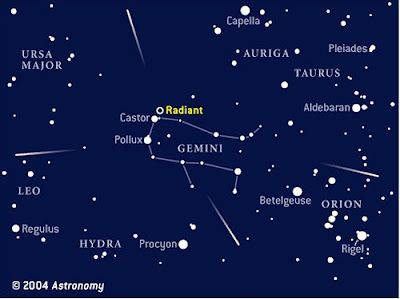Geminids meteor shower 2008
06 December 2008
A meteor shower (shooting stars or falling stars) is an increase in the number of meteors at a particular time of year. When a meteor appears, it seems to "shoot" quickly across the sky, and its small size and intense brightness might make you think it is a star. If you're lucky enough to spot a meteorite (a meteor that makes it all the way to the ground), and see where it hits, it's easy to think you just saw a star "fall."
Meteor showers are named by the constellation from which meteors appear to fall, a spot in the sky astronomers call the radiant. For instance, the next meteor shower is the Geminids in the evening of December 13, 2008. This meteor shower gets the name "Geminids" because it appears to radiate from the constellation Gemini.
The Geminids are not ordinary meteors. While most meteor showers come from comets, Geminids come from an asteroid—a near-Earth object named 3200 Phaethon. Some opinions told that 3200 Phaethon used to be a comet, but I'm not sure at all, because I have never observated this object actually.
Well, an observer in the Northern Hemisphere can start seeing Geminid meteors as early as December 6, when one meteor every hour or so could be visible. During the next week, rates increase until a peak of 50-80 meteors per hour is attained on the night of December 13. The last Geminids are seen on December 18, when an observer might see a rate of one every hour or so. For observers in the Southern Hemisphere, the Geminid radiant never climbs far above the horizon, and this considerably reduces the number of Geminid meteors you are likely to see.
Geminids meteors can be seen anytime after 10 p.m. local time, when the constellation Gemini is well above the horizon, but the best time to look is during the early morning hours between about 2 a.m. and dawn. That's when the local sky is pointing directly into the Geminid meteor stream.
Gemini rises about 08:00 p.m. local time at mid-latitudes in the Northern hemisphere. The radiant of the Geminid shower is located near Castor, one of the two bright stars in Gemini (the other bright star is Pollux). To find the constellation at 2:00 a.m., go outside and face south. Castor and Pollux will appear approximately 45 degrees above the horizon. Earlier in the evening, from 10:00 p.m. until midnight, Gemini will be about 30 degrees above the horizon in the southeast.
So, why don't us try to see this meteor shower next week together?
Subscribe to:
Post Comments (Atom)

4 orang memberi komentar:
bisa dilihat di langit cerah bandung ga kk??
@anggriawan:
bisa...tapi harus agak gelap lah...lebih keren klo diliat di lembang/cikole, soalnya langitnya lebih bersih...
pokoknya ntar keren lah...soalnya meteor showernya warna-warni...dan jumlahnya cukup banyak
duhh, langit dibandung udah mulai gak bersahabat. waktu beberapa bulan lalu bisa liat bintang. sekarang, gak keliatan sama sekali. masa sih, harus naek gunung dulu.. :P
@Taruma:
skrg keseringan kabut di langit yang agak tinggi...
tp masih bisa kok ga naik gunung, kemarin cuma ngeliat sekali, tp sekaligus 3 bintang jatuh...
keren lah...
Post a Comment